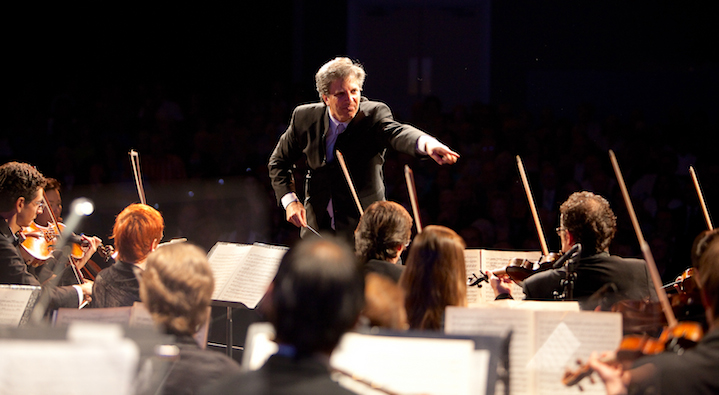I can’t think of a more enthusiastic endorsement than seeing members of the Toronto Symphony Orchestra literally go out of their way to play for a conductor.
- Classical Music 101: What Does A Conductor Do? - June 17, 2019
- Classical Music 101 | What Does Period Instrument Mean? - May 6, 2019
- CLASSICAL MUSIC 101 | What Does It Mean To Be In Tune? - April 23, 2019
Just think about it: These people are the highest-paid orchestral musicians in Toronto, they have 40 or so weeks of guaranteed work, little free time, and they get to play for a roster of internationally recognized conductors, young and old. And they will still find ways of getting to the Regent Theatre in Oshawa six times a year — including this Saturday — to make up the freelance core of that municipality’s resident classical ensemble alongside players from the COC and National Ballet orchestras, and even Tafelmusik members.
They will also be gathering in Toronto — at Koerner Hall for an opera-themed concert with tenor Richard Margison next Tuesday.
The person who inspires them so is Montreal native Marco Parisotto, who took over what was then the Oshawa Philharmonic in 1996 and has, over the last 17 years turned the group into an international-quality orchestra.
Just a week ago, Parisotto was leading a concert programme of Schumann and Rachmaninov by the Giuyang Symphony Orchestra in China. Last month, he was named the new music director of the Orquesta Filharmonica de Jalisco, one of Mexico’s most prestigious ensembles. He starts his new duties in February.
But despite all this, the most common reaction one gets when mentioning his name in Ontario is — who?
So let’s call Parisotto connoisseur’s conductor; the kind of leader you can take your fussiest symphony-loving friend to see.
I have to admit that, like so many other Toronto-centric musicgoers, I waited until Parisotto’s first Koerner Hall concert with the Ontario Philharmonic before I took notice. What happens in Durham Region stays in Durham Region, I thought. But what happens at Koerner Hall needs to be shared with everyone.
Now that I’ve seen and heard Parisotto in action three times — once at home base, the acoustically challenging but aesthetically welcoming Edwardian-era Regent Theatre in downtown Oshawa, and twice at Koerner Hall — I can vouch for his consummate attention to detail as well as an iron command of bigger musical canvases.
The Ontario Philharmonic’s programme on Saturday and Tuesday is all about the larger-than-life world of opera with the larger-than-life tenor Margison. But it would be nothing without the details.
I asked Parisotto how it can be that he continues to have a low profile in the area he calls home.
“I have no answer,” is Parisotto’s earnest reply. The Montreal native launched his career with a string of prestigious competition wins in Europe in the 1990s, lived in Paris for eight years and has spent quite a bit of time in Latin America. But he has been around the GTA as a resident for the last eight of his 17 years with the Ontario Philharmonic.
“You don’t see me at the Toronto Symphony, but it’s not for a lack of trying,” he says.
As for his success in Oshawa, Parisotto cites two things: the large number of Toronto symphony lovers who have moved out to Durham Region and his fiery love of his job.
“People think a regional orchestra doesn’t have the quality the Toronto Symphony does,” Parisotto explains. “But it doesn’t matter where you do music; it’s the attitude that counts. The way I do music anywhere is with the utmost conviction and passion.
“I don’t care if I’m at the Théâtre des Champs Élisées or the Barbican or the Regent Theatre,” he underlines. “It’s all the same to me.”
Last year, the organization was able to raise enough money to present three concerts at Koerner Hall, but it proved too expensive to repeat right away, so only two of this season’s programmes are being performed in both cities. (The previous one was cellist Matt Haimovitz as well as a rousing interpretation of Gustav Mahler’s Symphony No. 1 in November.)
Parisotto believes the economics of presenting serious symphony programmes don’t work without serious government support (something that this week’s dismal financial results from the Toronto Symphony clearly back up), and cites the lavish state support for symphonic music and opera in Mexico as a major incentive to take on a new job that will allow him to lead in an opera pit as well as a symphony stage.
“There’s an actual budget,” he emphasizes. The orchestra is also getting a big, shiny new home soon — with acoustics by Bob Essert, the genius behind the fine sound at Toronto’s Four Seasons Centre, Koerner Hall and, now, Jeanne Lamon Hall.
I asked Parisotto what his dream Ontario Philharomic season might look like.
“It would have at least 10 programmes,” he replies without hesitation. “It would include some major Romantic works, pieces from the 20th century and the Classical era as well as compositions of today. I would love to be able to commission new music.
“But I’m completely realistic,” he continues. “That’s not going to happen for a while.”
Parisotto says the Ontario Philharmonic is his baby, and will keep at it. He adds: “I’ve finally been able to bring it to attention, and it took a long time.”
For details on the concerts with Richard Margison, click here.
John Terauds
- Classical Music 101: What Does A Conductor Do? - June 17, 2019
- Classical Music 101 | What Does Period Instrument Mean? - May 6, 2019
- CLASSICAL MUSIC 101 | What Does It Mean To Be In Tune? - April 23, 2019




